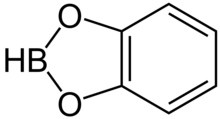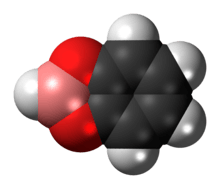Catecholborane
Catecholborane (abbreviated HBcat) is an organoboron compound that is useful in organic synthesis. This colourless liquid is a derivative of catechol and a borane, having the formula C6H4O2BH.
 | |
 | |
| Names | |
|---|---|
| IUPAC name
Catecholborane | |
| Other names
1,3,2-benzodioxaborole 7,9-dioxa-8λ2-borabicyclo[4.3.0]nona-1,3,5-triene | |
| Identifiers | |
3D model (JSmol) |
|
| ChemSpider | |
| ECHA InfoCard | 100.005.447 |
| EC Number |
|
PubChem CID |
|
| UNII | |
CompTox Dashboard (EPA) |
|
| |
| |
| Properties | |
| C6H5BO2 | |
| Molar mass | 119.92 g/mol |
| Appearance | Colorless liquid |
| Density | 1.125 g/cm3, liquid |
| Melting point | 12 °C (54 °F; 285 K) |
| Boiling point | 50 °C (122 °F; 323 K) at 50 mmHg |
| Hazards | |
| GHS pictograms |   |
| GHS Signal word | Danger |
GHS hazard statements |
H225, H314 |
| P210, P233, P240, P241, P242, P243, P260, P264, P280, P301+330+331, P303+361+353, P304+340, P305+351+338, P310, P321, P363, P370+378, P403+235, P405, P501 | |
| NFPA 704 (fire diamond) | |
| Flash point | 2 °C (36 °F; 275 K) |
Except where otherwise noted, data are given for materials in their standard state (at 25 °C [77 °F], 100 kPa). | |
| Infobox references | |
Synthesis and structure
Traditionally catecholborane is produced by treating catechol with borane (BH3) in a cooled solution of THF. However, this method results in a loss of 2 mole equivalents of the hydride. Nöth and Männig devised a more economical method involves the reaction of alkali-metal boron hydride (LiBH4, NaBH4, of KBH4) with tris(catecholato)bisborane in an ethereal solvent such as diethyl ether.[1] In 2001 Herbert Brown released an additional procedure for catecholborane synthesis. His method involves treating tri-O-phenylene bis-borate with diborane in a solution of either triglyme or tetraglyme. Brown claimed his method produces 85% yield of 97% pure product, catecholborane.[2]
Unlike borane itself or alkylboranes, catechol borane exists as a monomer. This behavior is a consequence of the electronic influence of the aryloxy groups that diminish the Lewis acidity of the boron centre. Pinacolborane adopts a similar structure.
Reactions
Catecholborane is a less reactive in hydroborations than borane-THF or borane-dimethylsulfide.
When catecholborane is treated with a terminal alkyne, a trans vinylborane is formed:
- C6H4O2BH + HC2R → C6H4O2B-CHCHR
The product is a precursor to the Suzuki reaction.[3][4]
Catecholborane may be used as a stereoselective reducing agent when converting β-hydroxy ketones to syn 1,3-diols.
References
- Process for producing catecholborane - Patent 4739096
- New Economical, Convenient Procedures for the Synthesis of Catecholborane
- Janice Gorzynski Smith. Organic Chemistry: Second Ed. 2008. pp 1007
- Miyaura, Norio; Suzuki, Akira (1990). "Palladium-Catalyzed Reaction of 1-Alkenylboronates with Vinylic Halides: (1Z,3E)-1-Phenyl-1,3-octadiene". Organic Syntheses. 68: 130. doi:10.15227/orgsyn.068.0130.
